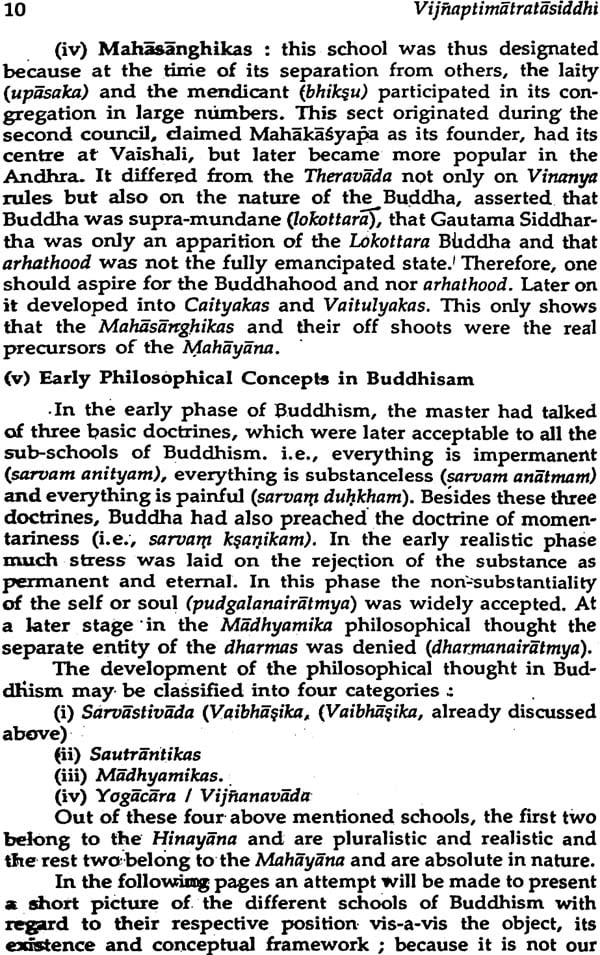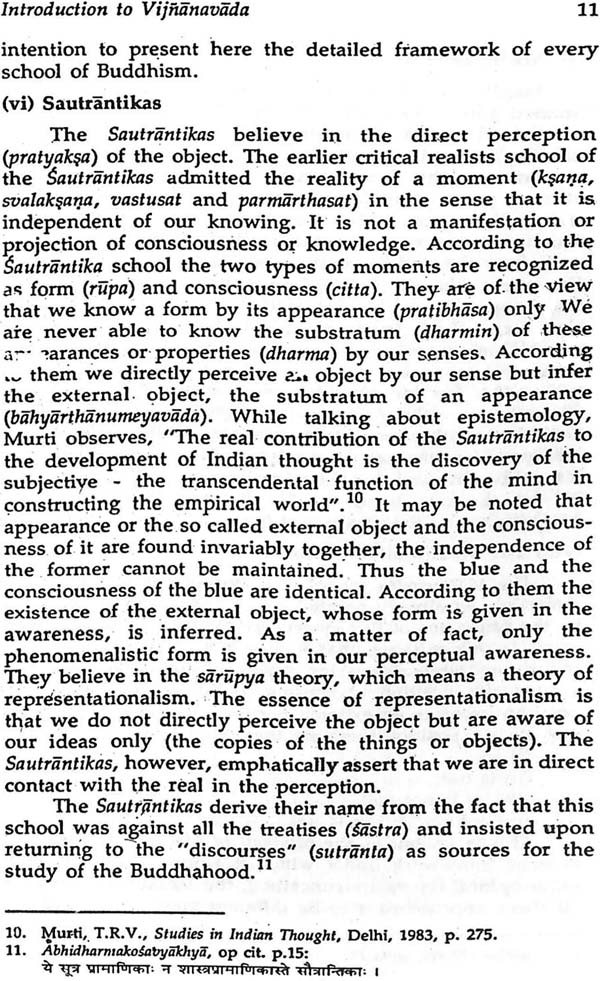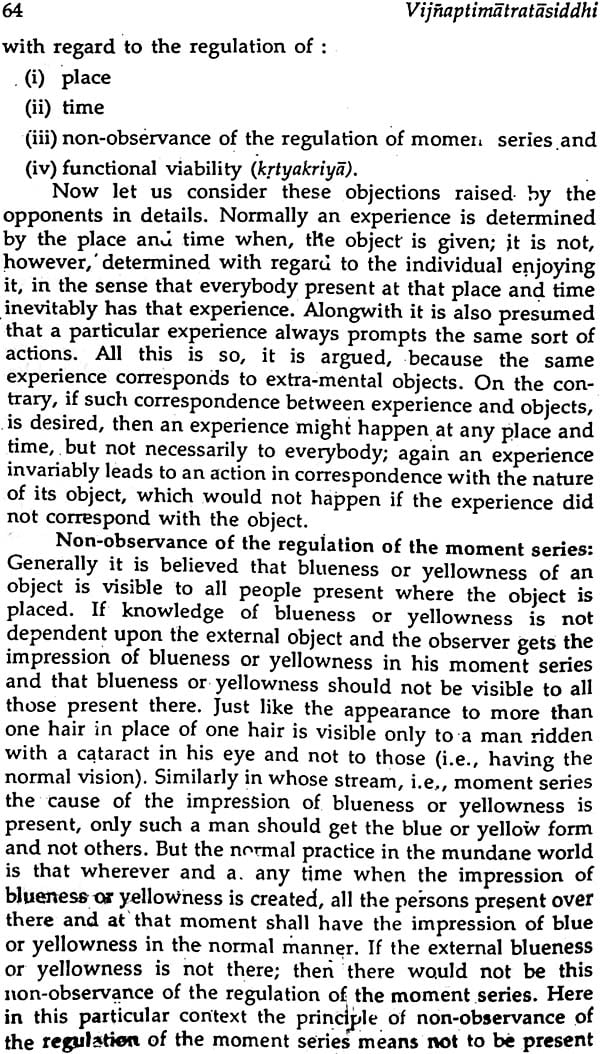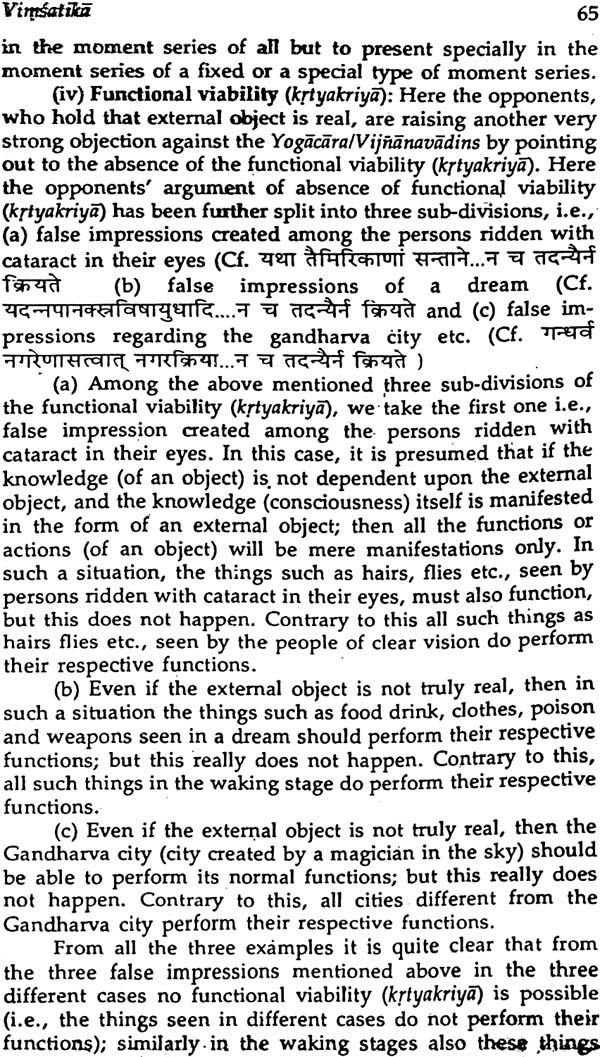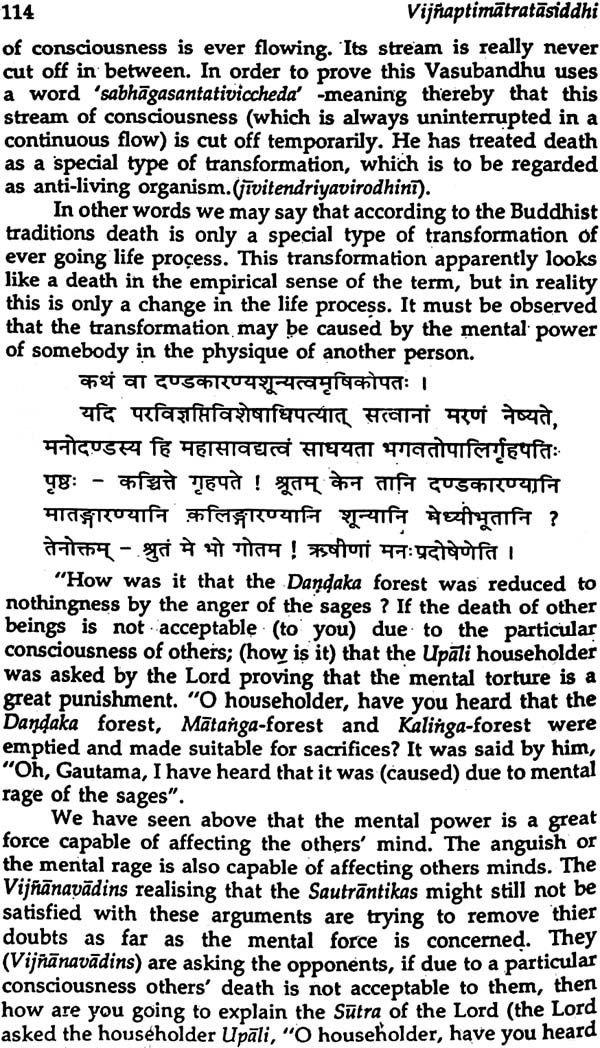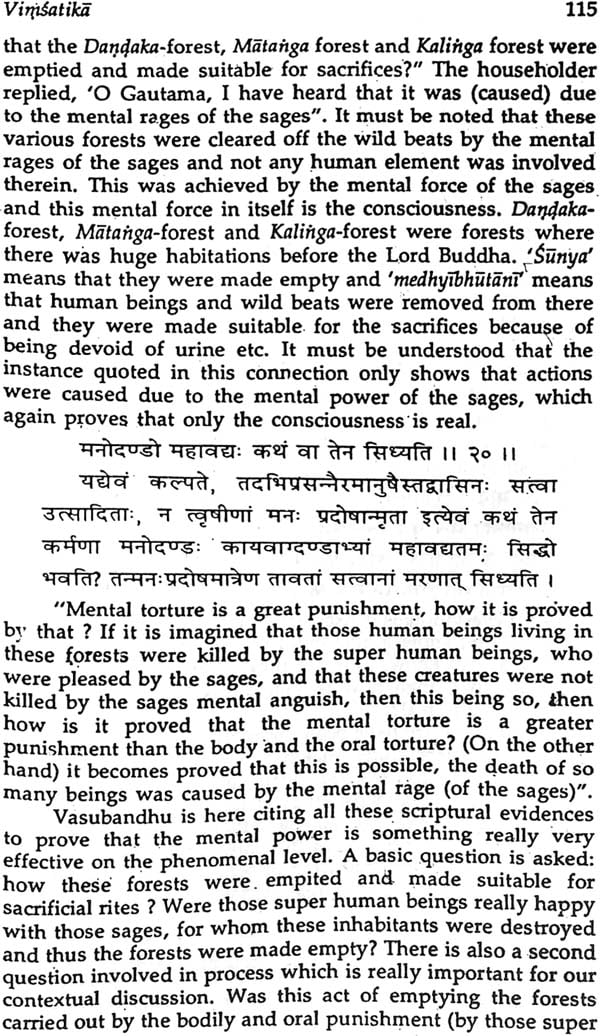
Vijnaptimatratasiddhi - Vimsatika (With Introduction, Transltion and Commentary)
Book Specification
| Item Code: | NAP192 |
| Author: | T. R. Sharma |
| Publisher: | Eastern Book Linkers |
| Language: | English |
| Edition: | 2017 |
| ISBN: | 9788178543413 |
| Pages: | 129 |
| Cover: | Hardcover |
| Other Details | 9.0 inch X 6.0 inch |
| Weight | 300 gm |
Book Description
The Vijnaptimatratasiddhi (Vimsa-tika) of Varubandhu is a basic treatise dealing with the Yogacara/Vijannavaja. The author, Vasubandhu has himself written a commentary on it. The Vimsatika in the twenty karikas tries to establish that consciousness (Vijnapati) is the only reality. The book is divided into two parts. The first part deals with the introduction to Vijnnavada. The introduction gives a detailed background of the Yogacara, its development and literature. The introduction makes a comparative study of the approach towards an object (artha) of the different philosophical schools of Buddhism. In the introduction is also discussed why Vijnnavada is called Yogacara. An attempt has been made to show how the perceptual and the conceptual images are necessary for a proper understanding of consciousness (Viplapti). The two concepts of early Buddhism, Viz, pudga-lanairairatmya and dharinanaira-tmya have been explained. Vasu-bandhu's refutation of atomism has been discussed, in greater details with the help of a diagram, Sankara's refutation of atomism has also been given, which is followed by a detailed analysis of Vimsatika, the meaning of Vijna-ptimatra and the signifi-cance of the suffix ‘ta’.
T.R. Sharma (b.1937), M.A. Ph.D. from University of Delhi, is a Reader-in-Sanskrit at S.G.T.B. Khalsa College, (University of Delhi). Sharma has been teaching for the last thirty two years both at the undergraduate and at the post-graduate level. For the last five years Dr. Sharma has been teaching Buddhist Philosophy at the Department of Buddhist Studies, University of Delhi. He has published four books : Studies, in the Sectarian Upanisads, (3) Svetasvatarupanisad, (3) Bharhuta Stupa and (4) Dharma ka Udbhave Aur Vikasa. Two of them have been awarded prizes by the U.P. Sanskrit Academy and Hindi Sansthana. He has also been awarded a prize by the Sanskrit Academy, Delhi Administration Delhi for the best teacher in the year 1991-92.
It is indeed a very difficult task to talk with any amount of certainity of the commencement of Vijnanavada because the genesis of the system may be traced book to the earliest stages of development of the Buddhist philosophy. It is only with regard to the stage of any particular system of philosophy that we become fully aware of it as a full-fledged system of philosophy. From all records available to .us, both historical and philosophical-we may say that Maitreya may be regarded as a progenitor of the Yogacara / Vijnanvada school of philosophy.
According to the Tibetan tradition Maitreya is supposed to have written the five works viz., (i) Sutralankara (ii) Madhyanta-Vibhanga, (iii) Dharma-dharmata- vibhanga, (iv) Abhisamayankara, and (v) Uttaratantra, whereas the Chinese tradition enumerates the Yogacarabhumi Yogavibhanga (now lost), Mahayanassutralankara Madhyantavibhaga and Vajrachedikavyakhya as the works of Maitreya. It must be obsreved that there are three different traditions of the nucleus of the philosophical ideas associated with the Vijnanvada, Viz, Chinese, Tibetan and Indian. As a result of modem researches it has been now possible that some of the works concerning idealism, which were earlier only available to us in Chinese and Tibetan traditions, have now been also transferred to Indian tradition. We may surmise that possibly there must have been some common stock of a rich philosophical ideas or concepts concerning idealism where from all the above said three different traditions might have derived their respective inspiration. According to some scholars the Yogacarabhumi may be considered as a fundamental text of the Yogcara.
The Mahayana school of Buddhist philosophy is represented by Madhyamika and Vijnanvada and it may be said that the two are not fundamentally different from each other in the ultimate analysis. Hajime Nakamura says in this regard, "The philosophy of viodness presented before us with the following principal doctrines; Voidness, Dependent Origination; Existence. under conditions (prajnapti) and the middle way. They were all incorporated into the system of Vijnanvda, which is quite accomodating to the structure of-human existence, and uses such terms as dharmas, vijnanas, alaya-vijnana, parinama, bijavasana etc. in order to prove to educe the real fact of experience."' In Hinayana, the two earlier schools of philosophy viz., Sautrantikas and the Vaibhasikas had accepted the external reality of the object (artha) whereas in the Mahayana, both the Madhyamika and Vijnanvada, denied the external reality of the object and both of them reduced the object to Sunya (void) and vijnapti (consciousness) respectively. Both schools had rejected the object at the phenomenal level (though accepting its physical existence) and had accepted it at the noumenal level. While doing so the Vijnavada schools of philosophy built a system which is called the doctrine of Vijnaptimatra or cittamatra.
In the Yogacara philosophical system terms like alaya vijnana, cittamatra, vijanana and vijnaptimatra are frequently used. They represent the central concepts in the works such as the Sandhinimocanasutra and Lankavatarasutra. Among all these terms cittameitra is undoubtedly one of the most complex and difficult term for a number of reasons. From its various usages both in the Yogacara and Madhyamika works it appears to be associated with (i) purely philosophical and the critical speculation and also (ii) with spiritual meditative pratices. It was also used to emphasize the primary importance of meditative technique as a means of gaining an unimpeded view of the ultimate reality. We should always be careful with regard to its changing context. The original concept of vijnantimatra can be traced back to the Sandhinirmocanasutra, from where Asanga quotes one passage in his Mahayana-samgraha: 'Maitreya asked : Lord, are these images. cognised in meditation different from that mind (which cognises them) or are they not different ? The Lord answered; Maitreya, they are not different, And why ? Because those images'are nothing but cenceptaulization (vijnaptimatra). Maitreya, I have explained that the meditative object (alambana) of consciousness (vijnana) is comprised of (prabhavita) nothing but conceptualization (vijnaptimatra).’
From the above quotation of Asanga it is quite clear that term like cittamatra and vijnaptimatra pertain to actual meditative Instruction and practice. Probably this may also appear to be one of the reasons for the system of philosophy of idealism to be called as Yogacara. The Yogcara is indeed concerned with mind (citta) its nature, development and its working.
It is well known that Lankavatarasutra is supposed to be the prominent work to have a full-blown idealism in it. Some scholars are of the view that this work is syncretic in nature. From its vast contents concerning idealism it can be said that it grew gradually collecting discussions on a great variety of topics which interested the idealistic movement. There is no doubt that this text has gone into the minutest possible detailed analysis of the mind (citta). It has established that - whole universe is just a manifestation of the mind (citta) itself. This very idea has four —I favour with most of the works dealing with Yogcara / Vijnanvada philosophy. However, we should note in passing that the Lankavatarasutra had identified the concept of alayavijnana with the concept of tathagatagarbha and it may be pointed Out that such an identification has not been acceptable by the early Yogacara of Asanga Vasubandhu school.
Contents
| Preface | i-v | |
| Part I | 1 - 52 | |
| 1 | Introduction to Vijnanavada | |
| (i) | Vasubandhu, his Life and Works | 1 |
| (ii) | Virnatika (Karika and Vrtti) | 1-3 |
| (iii) | Background of Yogacara | 4 - 5 |
| (iv) | Sautranika Approach towards an object | 5-7 |
| (v) | Philosophical schools of Buddhism | 8-13 |
| 1 | Sthaviravada | 8 |
| 2 | Sarvastivada (Vaibhasika) | 8 - 9 |
| 3 | Sammatiya | 9 |
| 4 | Mahasanghikas | 10 |
| 5 | Early Philosophical Concepts in Buddhism | 10 |
| 6 | Sautrantikas | 11 |
| 7 | Madhyamikas | 12 |
| 8 | Madhyamika Dialectics | 12 - 13 |
| (vi) | The Origin and Development of the Yogacara Literature | 13 - 15 |
| (vii) | Why Vijnanavada is called Yogacara | 16-18 |
| (viii) | Basic Philosophical Tenets of Yogacara/Vijnanvada | 18-19 |
| (ix) | Perceptual Image and Conceptual Image | 19-22 |
| (x) | Agamanuyayi Tradition of Vijnanavada | 22 |
| (xi) | Yuktiyanuyayi Tradition of Vijnanavada | 23 |
| (xii) | Common characteristics acceptable to both the traditions | 24 |
| (xiii) | Non-Subtantiality of the Self and Dharrnas (Pudgalanairatmya and Dharmanairatmya | 25-28 |
| (xiv) | The Three Vijnanas | 28 |
| (xv) | Alayavijnana | 28-30 |
| (xvi) | Klistamano Vijnana | 30-31 |
| (xvii) | Refutation of Atomism | 32-37 |
| (xix) | Sankara's Refutation of Atomism | 37-38 |
| (xx) | A Detailed Analysis of Vimsatika | 38-41 |
| (xxi) | The Meaning of Vijnaptimatra | 41-48 |
| (xxii) | Significance of the Suffix 'ta' | 48-51 |
| Part II | 53-119 | |
| Appendix | 120-122 |
